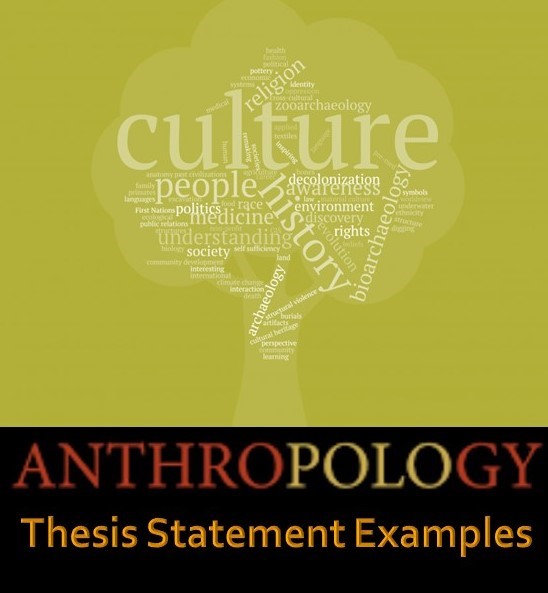The anthropological thesis statements are one of the most crucial elements of most essays or research papers. What your research will demonstrate and what you hope to persuade your readers once they have read your thesis is stated in your thesis statement. This is the core of the entire piece and explains precisely what you hope to accomplish and what you hope to establish or refute. This thesis statement will serve as the foundation for the whole of the work unless you are recording research or writing a purely descriptive essay, in which case you should consider it carefully.
What Function Does a Thesis Statement Serve?
The primary idea and central argument of a paper should be highlighted in the thesis statement. Without it, the reader lacks the basis to comprehend the arguments, examples, and data the author uses to support their points throughout the paper. A paper without a thesis statement would be made up of unrelated facts and ideas. A thesis statement provides a conclusion and the framework for how a writer will get there. A paper without a thesis statement is like giving someone random directions with no goal in mind.
Below are 31 anthropology thesis statements that will give you an idea of how to write an anthropology thesis statement;

Anthropology Thesis Statement Examples
1.
Expanding on Levi- Strauss’s Analysis of Social Structures
Strauss claims that structuralism encompasses a broad spectrum of social processes. He maintained that the structures of a primitive mind and a civilized mind are the same and that human qualities are universally shared at their core. What precisely was Strauss’ notion of structuralism, how far could it be applied, and is there any relevance for it in terms of how historians view the past?
2.
The Selfie’s Effects on Culture and Society
Selfies have been taken and shared using technology for almost 20 years, and the practice is still thriving as a digital ethnographic habit. Although taking this kind of picture is a simple process, there is undoubtedly a more profound knowledge of the human and cultural contexts underlying these visual representations. The cultural and societal elements included in selfies must be examined with references to anthropological ideas.
3.
In the Genetic Age, Anthropology of “Others” and Bioculturalism
In recent decades, there has been a change in the epistemology of the study of “identity.” For a long time, anthropologists have worked to separate identity from the idea of a fixed object of study, claiming that this idea is solely the result of social performance and has a collective aspect that results from navigating existing political institutions. However, human genomics research advances counter this perspective because identity or distinctions have a biological basis. Through several different avenues of inquiry, anthropology has started to explore these issues: How has this recent genetic research affected how people develop identities and understand their heritage? What conceptual or methodological foundations enable anthropology to deal with the fallout from the genetic revolution?
4.
Forensic Anthropology’s Code of Ethics
According to research, forensic anthropology is a susceptible field that calls for professionalism and dedication from all parties involved. While pursuing their education, conducting their research, and developing their careers, forensic anthropologists run across several ethical dilemmas. It is urgently necessary to review forensic anthropology’s current ethics condition regarding its application, level of professionalism, and resolving numerous legal issues.
5.
Signaling in Human Breasts
Darwin theorized that the form of human breasts is peculiar among mammals and may have evolved to improve mating success by alluring partners. On our globe, there are more than 5,000 different species of mammals, but only homo sapiens have permanent breasts. To produce milk, all other mammals generate transient breasts during ovulation or when feeding a newborn. However, a female human’s breasts grow throughout puberty, indicating a different evolutionary process. There are various theories about why human breasts are continuously engorged, but the exact cause is unknown.
6.
Anthropological Studies and the Concept of Culture
Although the concept of culture may become more prevalent in public discourse, anthropology has instead witnessed a gradual trend away from culture. In anthropological discourse, the idea of culture remains problematic since it presumes a self-other dichotomy, reinforcing divisions that inevitably result in a hierarchy. But what is the reason for anthropologists’ lack of enthusiasm for culture? Though culture may no longer serve as an analytical notion for anthropology, it is nonetheless more crucial than ever as an ethnographic research subject. However, if we suppose that culture is a flawed organizing principle for anthropology, it should still be retained because it is still incredibly effective in helping anthropology solve the problems of the twenty-first century.
7.
Factors Behind Different Societies’ Death Rituals
The reactions to death vary depending on the traditions and beliefs in the society, even though death is a universal component that affects everyone in all civilizations. The deceased’s individuality is preserved in various cultures and is honored through funeral rites. The anthropological study of funeral ceremonies is essential to comprehending the complexity of death as the globe becomes more interlinked. This makes it easier to understand, respect, and react in meaningful ways to cultures distinct from one’s own. From an anthropological perspective, the ritualistic nature of the death ceremony and its social functions hold different meanings.
8.
Study on Chinese Students’ Perceptions of the Giant Panda
People in China, the giant panda’s native country, have shown a willingness to pay (WTP) for the species’ preservation, which is sufficient evidence that this endearing animal may find a home. Yang (2005) examines the connection between Chinese people’s attitudes toward the giant panda and the portrayal of the animal in the media. She concludes that the attitude in China is probably more likely to be linked to symbolic and domestic values than ecological and scientific values. However, since this judgment was made based on the literature study, it may not accurately represent how people feel. Thus, further research into this mindset is necessary.
9.
AIDS Prevention Project and the New Paradigm Fund, Edward C.
The eminent anthropologist Edward C. Green’s life and career are examined in this paper. The Harvard AIDS Prevention Project, founded and led by Edward Green to reduce the prevalence of HIV and other infectious diseases in Africa and other parts of the world, will also be highlighted in combination with his biography in this paper. Edward Green, an anthropologist, had different ideas about how to fight AIDS and spent the rest of his life and career working to improve health outcomes for underserved groups of people. The perspective presented in this paper will contrast the conventional biomedical understanding of AIDS and ways to prevent it.
10.
China’s Individualism: A TV Case Study
A revolution that tends to strengthen an individual’s rights is individualism. A practice like this is common in nations like America. The locals there want everyone to have ample personal space without being bothered by the name of any authority or power. In contrast, collectivism—the exact opposite culture or practice—predominates in China. Here, neither an individual’s wish nor thought is given priority. They work together to achieve group success because they value collective intelligence. A similar technique might likewise require everyone to think the same thing. However, they have been adhering to this culture for a long time.
11.
Ethnicity and Acculturation in Consumer Behavior
Cultural processes—in particular, what has come to be known as acculturation—help us to understand the purchasing habits of consumers from ethnic minorities. It is crucial to demonstrate how acculturation affects ethnic minority consumers’ purchasing decisions and how it aids in understanding their buying habits.
12.
Whistleblowers: Ethical Conundrums and Government Function
In most civilized nations, all professional occupations are performed within the confines of a specific Code of Conduct that is publicly known and understood by employers and employees. In uniformed groups like police forces, whistle-blowing tends to get more attention from academics with various backgrounds, including political science, history, law, sociology, and psychology. We must understand who whistleblowers are, their work, and the moral problems they encounter while carrying out their jobs, notably in law enforcement (Police Officers).
13.
The Cornerstone Of Social Life Is Exchange
The transfer of items between social and actors is referred to as “exchange” in the Encyclopedia of Social and Cultural Anthropology. Things can be words or things, human or animal, material or immaterial. The actors could be one-off people, a group, or supernatural beings like gods and spirits. In a broad sense, commerce and barter are two examples of exchanges. It can be said that the exchange of gifts forms the cornerstone of social life.
14.
Evolution of Primate Body Structure and Movement
Even though humans no longer primarily live in trees, they retain some physical adaptations for climbing them. Their hands, in particular, still maintain an arboreal shape. Through the evolution of primates, several changes in movement and body structure took place. Some of these changes are obvious, while others call for more in-depth study.
15.
Perspective on Sickle Cell Disease: Genetic Anthology
Sickle Cell Disease (SCD) is inherited, which means that genes from one set of parents are passed on to the next. Two defective hemoglobin genes, one from each parent, are inherited by people with SCD. SCD can take many forms, but the most severe and prevalent one, sickle cell anemia, disproportionately affects African-Americans and Hispanics in the US. SCD has possible hereditary benefits, social ramifications, and present societal repercussions.
16.
Impact of Casual Clothing at Work
The need to return to a condition of elegance as a new approach to displaying professionalism and the gradual but steady shift away from the formal dress code are the two main drivers of the rising trend of casual wearing in the financial sector, with particular attention in Bank of America. Casual attire has its potential repercussions within the setting of Bank of America.
17.
Islamic Law and Property Ownership
This paper highlights the influence of Islam on Muslim women’s property ownership. Look at what the Islamic faith says about women owning property and the current reality, how the Islamic faith interacts with custom and the law and how it affects how Muslim women possess property in Muslim-majority areas.
18.
A History of Interpreting Indigenous Culture through Art
To address the question of how contemporary Indigenous artwork, such as paintings and films, has lessened the stereotypes created by non-Indigenous people, this research paper will discuss the differences in Indigenous artwork throughout history.
19.
Modern Behavior: African Stone Age Records from the Middle Stone Age
Developed behavioral characteristics that we connect with “modern” humans are called behavioral modernity. What we now categorize as modern human behaviors are cultural universals common by all people; these behaviors include characteristics like language, religion, and decorating, or what are referred to as the “behavioral B’s”: blades, beads, burials, manufacturing bone tools, and beauty. We need to look for the arguments supporting the identification of contemporary behavioral tendencies in the African Middle Stone Age (MSA) record.
20.
Canadian Poverty’s Root Causes
This research examines some of the factors contributing to poverty in Canada against the contentious causes of poverty, paying particular attention to whether those who are poor voluntarily choose to be such. Even though some human characteristics may account for the poor, the study contends that poverty is also a result of structural flaws and that no matter how much individual reforms are made, poverty will endure if commensurate structural changes are not implemented.
21.
Chiefdoms And Tribes: Their Differences
Two distinct African chiefdoms are the Mayogo in the Northern Democratic Republic of Congo and the Swazi in Southern Africa. The existence of the two chiefdoms within the borders of numerous African nations is explained by the fact that they share more in common with states than with tribes. The chiefdom and the state have many similarities, which accounts for why there is less friction between the two institutions than between the state and the tribe. The research paper will focus on kinship, marriage, and citizenship to study the two chiefdoms of Mayogo and Swazi through comparison with the nation and the tribe.
22.
Marriage Rituals Interpreted Symbolically: Kom Marriage
It depends on the individual whether the marriage is monogamous or polygamous in Kom. Other types of marriage include civil unions and religious unions. Conventional marriage consists of three basic phrases, and families can follow all three or just one. The Kom people have witnessed an evolution in marriage rituals and practices as time has passed, which is why this essay will attempt to determine when a marriage has changed. What factors have triggered evolution? And how it affects customary marriage rituals and the Kom tradition, which the locals view as detrimental to their way of life.
23.
Gujarati Immigrants’ Integration In Britain
Understanding the relationships between social and economic integration and involvement in international activities is necessary. Since Gujaratis are usually recognized as being among the wealthiest, most successful, and most devout South Asian immigrants to Britain, they must be focused upon.
24.
Perception Of Parents Having Children With Down Syndrome
This paper is based on a comparison of how African and Western cultures see parents of children with Down syndrome. While the case study for the West will be based on ethnographic research with a family in Leuven, the case study for Africa will be based on my experience with Down syndrome children in Bamenda and other available material. This study will look at the various theories on the origins of Down syndrome and how they affect the interaction between the family and the child with the condition. This study will also examine the types of care offered in these various cultural contexts.
25.
Bahrain: Case Study on Career Discrimination and Gender
The case details the professional life and choices Ellen Moore made regarding her job while living abroad in Bahrain in the 1980s. Regarding her academic and professional background, Ellen is remarkable and competent. She immediately joined her spouse in Bahrain to begin work as a financial specialist after earning an MBA.
26.
Obesity in Children: Determinants and Solutions
Obesity is a severe accumulation of fat that causes a person’s weight gain to be at least 20% higher than their ideal weight. Physiological, emotional, and familial factors can all contribute to childhood obesity. However, a small proportion of inherited characteristics, such as thyroid problems, can cause childhood obesity.
27.
Discrimination Based On Gender And Religion In Islamic Nations
Some social vices thought to have been eliminated long ago are very prominent in our culture today. This essay aims to expose the wrongs of religious law-based discrimination against minorities. Using Saudi Arabia as a case study, this study will discuss the spiritual and gender-based minorities in Islamic countries. The study’s central claim is that gender and religious discrimination are pervasive and persistent in countries with an Islamic cultural foundation. The conflicts and prejudices against minorities stem from religious cultures.
28.
Putting Islamic and Public Schools Side by Side
It has been researched for a while now how Muslim parents choose whether to enroll their children in public or Islamic schools, and it has given various responses to various problems. This study was primarily motivated by the mounting evidence that the multiple cultures and religions among people of different races worldwide contribute to cultural and political differences.
29.
Women’s Role In Anime: A Mirror Of Japanese Culture
What can be learned about the status of women in contemporary Japanese culture from the representation of women in animation? When discussing modern Japan, it’s necessary to explore the place of women in the culture. While data and survey results from more conventional study methods are significant, you also need to look at how the modern Japanese woman is portrayed in popular culture. We need to establish a link between Japanese animation, a kind of popular culture, and the status of women in modern Japanese society—specifically, whether this status is changing or staying the same.
30.
Singapore’s Consumer Culture And Fashion Industry
The landscape of the twenty-first century has been formed by perpetual consumerism. It generates an endless demand for goods and stores in every conceivable location. The retail design transforms this potential area into a “place for consumption.” People come into contact with intense pressure to view and purchase goods there. The world of fashion offers the ideal illustration to support your claim. Strong evidence suggests that apparel manufacturers compete fiercely to capture the market. To raise brand awareness among the public, the store has emerged as a crucial element or, to put it another way, a powerful statement. The dilemma is how a business might be built to send a powerful message to attract the “crowd of consumption” to the area in a somewhat oversaturated market.
31.
The Southeast Missouri Region’s Early Mississippian Peoples
There is a historical significance of people who may have been before the Cahokia Mound Builders of the Ohio River Valley. The available evidence for the existence of Paleolithic tribes in the southeast region of Missouri must be focused upon. There were different reasons why prehistoric Indians would have settled near what is now the Sac-Osage River just outside the town of Stockton, Missouri, the length of time they spent there, and the historically significant but now seemingly forgotten presence of an established and prosperous Indian settlement in this area before Cahokia.
FAQ’s
- Pick an anthropology thesis topic.
- For your project, prepare a proposal.
- Determine your thesis committee. Forward your idea to the committee members.
- Review the literature.
- Create a draft of your thesis and give it to your committee. Resubmit it after making any adjustments or additions that your committee requests. You can do this step as many times as necessary. Decide on a date and location for your thesis defense with your committee after they determine that you are prepared to defend your draft. At the graduate school, submit your defendable draught in the appropriate format.
- Support your thesis. When you succeed, submit the appropriate form to the graduate program. Make a final copy of your thesis, making that it follows the format specifications established by the graduate program. Create an outline, a title page, etc.
Although the method for developing a thesis statement varies depending on the type of writing and the subject, the thesis statement should always serve as the paper’s primary objective. This indicates that it might be a response to a query or prompt, a supported argument, or the central idea of a story. Most of the time, it should only be a few sentences long and appear at the start of your essay. A strong thesis statement is specific and open to challenge. It presents a novel theoretical point or explores the relationship between two concepts. It uses or criticizes another person’s reasoning.
Researchers can use the following guidelines to ensure that their thesis statements are written and used correctly in their research papers.
Know your topic. Something you already know or can learn about should be the subject. Even writing a thesis statement for a paper on a subject you are unfamiliar with might be challenging. You can learn more about your issue by researching it and reflecting on personal experiences.
Do not get off the subject. Limit your topic to a specific area based on what you already know and the length requirements for your final paper. A lengthier paper will typically be needed for a vast spectrum, but a shorter paper will generally be adequate to prove a limited focus.
It is best to include the research statement early in the paper. This assertion should be made around the conclusion of the paper’s introduction or in the second paragraph. When used correctly, the thesis statement makes the researcher’s position obvious and points the reader in the right direction. If your school or the publication you wish to publish in requires APA formatting, you might want to consult it for guidance on where to put the study statement.
Brainstorm. If you’re having problems starting your paper or formulating your anthropology thesis ideas, grab a piece and jot down any statements regarding the subject. Did you make any new connections or discoveries? Do you think you can classify any of the notes you made? Do you see any common themes? Consider incorporating the concepts you’ve learned into your thesis statement and paper.



